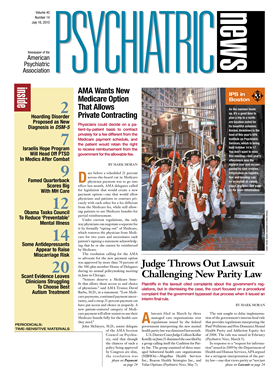The AMA House of Delegates approved two reports by the AMA's Council on Science and Public Health (CSAPH) on physician suicide and on lead levels and their effects on children.
Without debate or opposition the House approved an extensive report by CSAPH titled “Suicide in Physicians and Physicians-in-Training,” which concluded that “routine occurrence of burnout and mental disorders in physicians and physicians-in-training warrants examination and development of more transparent and efficient solutions.”
The report was the result of a resolution brought to the House of Delegates last year by the Section Council on Psychiatry.
The council performed a PubMed search of literature from 1970 to March 2010 using the terms “student/medical,” “internship and residency,” and “physicians” in combination with “mortality,” “suicide/epidemiology,” “burnout/professional,” and “stress/psychological.”
The council concluded that the periods of medical school and residency are stressful; that many medical students, residents, and practicing physicians experience substantial distress, which contributes to a decline in mental health and well-being; and that physicians often face barriers to the prompt diagnosis and treatment of mental disorders.
In response, the council advised the formation of an expert panel to address the subject and develop specific recommendations.
“Unfortunately, this is a huge problem among the medical student population,” said Ryan Ribeira, a representative from the Medical Student Section, at reference committee hearings on the report. “It's a personal issue for me as one of my own classmates decided to take his life a year ago, and the year before that a student in the class above me also committed suicide. Across the country I hear the same stories over and over again.... This is a very serious problem, and it is entirely appropriate that the AMA form an expert panel to address this issue.”
A second council report, also resulting from a resolution submitted by the Section Council on Psychiatry last year, updates a 1994 report on lead levels in children.
The new report noted that data since 1994 have shown impaired cognition, lowered IQ, and behavioral problems for children exposed to lead at blood concentrations below the Centers for Disease Control and Prevention's current “level of concern” of 10 μg/dL. One analysis of National Health and Nutrition Examination Survey (NHANES) data from 1988 to 2004 showed performance on cognitive tests was diminished in children with blood lead concentrations as low as 2.5 μg/dL.
Also, a 2006 analysis of NHANES data specifically evaluated lower blood concentrations as a risk factor for attention-deficit/hyperactivity disorder (ADHD), finding a “significant dose-response relationship” between blood lead concentrations and ADHD.
The CSAPH recommended that several policies be updated to reflect the findings of its report and proposed that the following new policy be adopted: “That our AMA urge the Centers for Disease Control and Prevention to give priority to examining the current weight of scientific evidence regarding the range of adverse health effects associated with exposure to blood lead concentrations below the current ‘level of concern’ in order to provide appropriate guidance for physicians and public health policy, and encourage the identification of exposure pathways for children who have low blood lead concentrations, as well as effective and innovative strategies to reduce overall childhood lead exposure.”
“This report offers reasonable recommendations based on data available and furthers our overall goal of enhancing awareness [of hazards associated with lead] even at levels currently considered in the acceptable range,” said APA Treasurer David Fassler, M.D., a delegate from the American Academy of Child and Adolescent Psychiatry.

